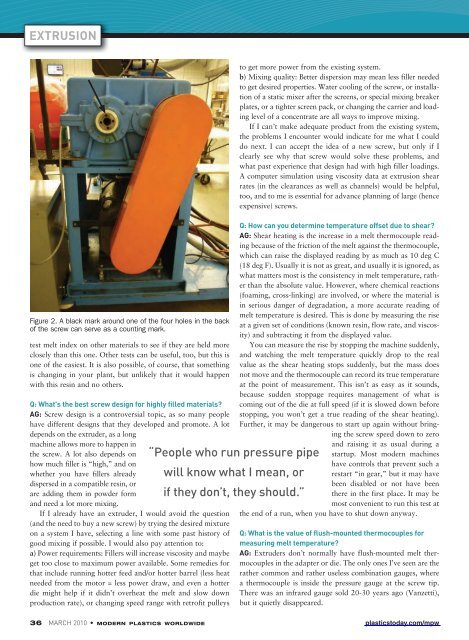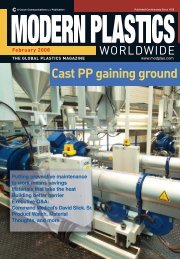Modern Plastics Worldwide - March 2010 - dae uptlax
Modern Plastics Worldwide - March 2010 - dae uptlax
Modern Plastics Worldwide - March 2010 - dae uptlax
You also want an ePaper? Increase the reach of your titles
YUMPU automatically turns print PDFs into web optimized ePapers that Google loves.
EXTRUSION<br />
Figure 2. A black mark around one of the four holes in the back<br />
of the screw can serve as a counting mark.<br />
test melt index on other materials to see if they are held more<br />
closely than this one. Other tests can be useful, too, but this is<br />
one of the easiest. It is also possible, of course, that something<br />
is changing in your plant, but unlikely that it would happen<br />
with this resin and no others.<br />
Q: What’s the best screw design for highly filled materials?<br />
AG: Screw design is a controversial topic, as so many people<br />
have different designs that they developed and promote. A lot<br />
depends on the extruder, as a long<br />
machine allows more to happen in<br />
the screw. A lot also depends on<br />
how much filler is “high,” and on<br />
whether you have fillers already<br />
dispersed in a compatible resin, or<br />
are adding them in powder form<br />
and need a lot more mixing.<br />
If I already have an extruder, I would avoid the question<br />
(and the need to buy a new screw) by trying the desired mixture<br />
on a system I have, selecting a line with some past history of<br />
good mixing if possible. I would also pay attention to:<br />
a) Power requirements: Fillers will increase viscosity and maybe<br />
get too close to maximum power available. Some remedies for<br />
that include running hotter feed and/or hotter barrel (less heat<br />
needed from the motor = less power draw, and even a hotter<br />
die might help if it didn’t overheat the melt and slow down<br />
production rate), or changing speed range with retrofit pulleys<br />
“People who run pressure pipe<br />
will know what I mean, or<br />
if they don’t, they should.”<br />
to get more power from the existing system.<br />
b) Mixing quality: Better dispersion may mean less filler needed<br />
to get desired properties. Water cooling of the screw, or installation<br />
of a static mixer after the screens, or special mixing breaker<br />
plates, or a tighter screen pack, or changing the carrier and loading<br />
level of a concentrate are all ways to improve mixing.<br />
If I can’t make adequate product from the existing system,<br />
the problems I encounter would indicate for me what I could<br />
do next. I can accept the idea of a new screw, but only if I<br />
clearly see why that screw would solve these problems, and<br />
what past experience that design had with high filler loadings.<br />
A computer simulation using viscosity data at extrusion shear<br />
rates (in the clearances as well as channels) would be helpful,<br />
too, and to me is essential for advance planning of large (hence<br />
expensive) screws.<br />
Q: How can you determine temperature offset due to shear?<br />
AG: Shear heating is the increase in a melt thermocouple reading<br />
because of the friction of the melt against the thermocouple,<br />
which can raise the displayed reading by as much as 10 deg C<br />
(18 deg F). Usually it is not as great, and usually it is ignored, as<br />
what matters most is the consistency in melt temperature, rather<br />
than the absolute value. However, where chemical reactions<br />
(foaming, cross-linking) are involved, or where the material is<br />
in serious danger of degradation, a more accurate reading of<br />
melt temperature is desired. This is done by measuring the rise<br />
at a given set of conditions (known resin, flow rate, and viscosity)<br />
and subtracting it from the displayed value.<br />
You can measure the rise by stopping the machine suddenly,<br />
and watching the melt temperature quickly drop to the real<br />
value as the shear heating stops suddenly, but the mass does<br />
not move and the thermocouple can record its true temperature<br />
at the point of measurement. This isn’t as easy as it sounds,<br />
because sudden stoppage requires management of what is<br />
coming out of the die at full speed (if it is slowed down before<br />
stopping, you won’t get a true reading of the shear heating).<br />
Further, it may be dangerous to start up again without bringing<br />
the screw speed down to zero<br />
and raising it as usual during a<br />
startup. Most modern machines<br />
have controls that prevent such a<br />
restart “in gear,” but it may have<br />
been disabled or not have been<br />
there in the first place. It may be<br />
most convenient to run this test at<br />
the end of a run, when you have to shut down anyway.<br />
Q: What is the value of flush-mounted thermocouples for<br />
measuring melt temperature?<br />
AG: Extruders don’t normally have flush-mounted melt thermocouples<br />
in the adapter or die. The only ones I’ve seen are the<br />
rather common and rather useless combination gauges, where<br />
a thermocouple is inside the pressure gauge at the screw tip.<br />
There was an infrared gauge sold 20-30 years ago (Vanzetti),<br />
but it quietly disappeared.<br />
36 MARCH <strong>2010</strong> • MODERN PLASTICS WORLDWIDE plasticstoday.com/mpw









